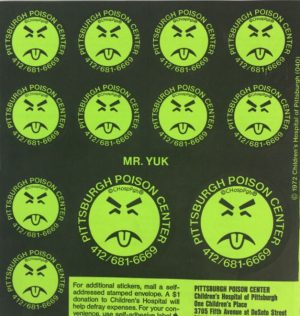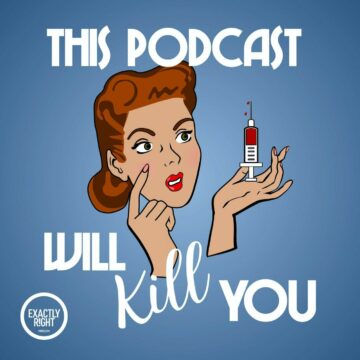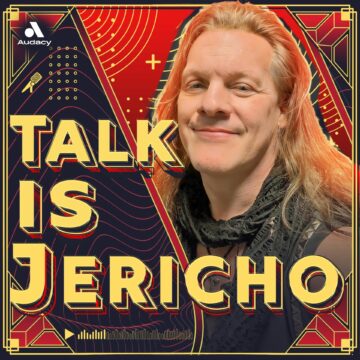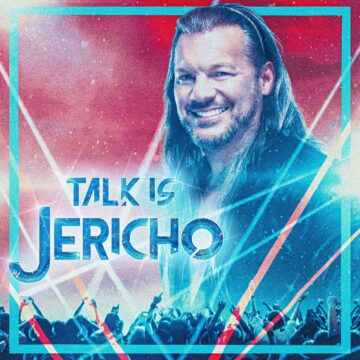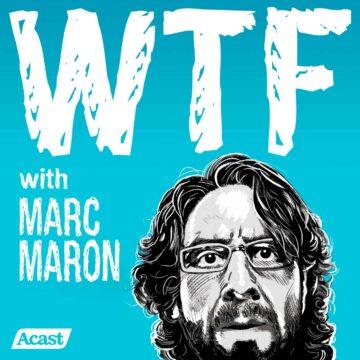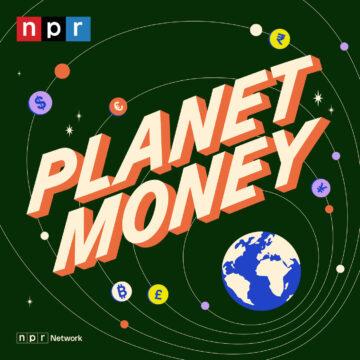Some of you may be familiar with a figure called Mr. Yuk, depending on your age and where you grew up, but for rest of you: Mr. Yuk is a neon green circular sticker with a cartoon face on it. His face is scrunched up with his eyes squeezed tight and his tongue is sticking out of its mouth. It’s the face you make when you taste something disgusting. He’s the pictorial embodiment of the sentiment of yuck.
 Aptly enough: he was designed to be the symbol for hazardous substances, aimed at deterring children from ingesting them. The idea what that if you saw a a Mr. Yuck sticker on something around the house, it meant that that something was poison. Parents would get sheets of these and stick them on drain cleaners, bleach boxes, and basically anything else kids might get their hands on.
Aptly enough: he was designed to be the symbol for hazardous substances, aimed at deterring children from ingesting them. The idea what that if you saw a a Mr. Yuck sticker on something around the house, it meant that that something was poison. Parents would get sheets of these and stick them on drain cleaners, bleach boxes, and basically anything else kids might get their hands on.
Mr. Yuk was created in 1971 by a physician named Doctor Richard Moriarty. He was pediatrician and the founder of the Pittsburgh Poison Center. And as head of the Poison Center, he naturally wanted to keep kids from ingesting potentially dangerous substances … but he also wanted to teach parents that when their kid still went ahead and ingested something anyway, they should call poison control first. That call could save you time, money, and a lot of stress.
Poison (Out of) Control
Poison centers are actually a pretty recent phenomenon; until the 19th century, people mostly had to rely on conspicuous packaging and poison labels for poison prevention. Apothecaries were required to store hazardous substances in irregularly shaped bottles so they wouldn’t be mixed up with other products. Also in the mid-1800’s it the American Pharmaceutical Association deployed a mandate to clearly label a bottle with the word “poison,” or with the medically accepted symbol for poison, like: a skull and crossbones.
 Still, even in the early 1900s, there actually still wasn’t a ton else being done in terms of preventative poison control. And this was a huge problem because around then a brand new danger was entering American homes: household cleaners. Lots of factors led to their adoption and spread at the time. For one, there was a whole chemical revolution taking place in the United States. At the same time, Americans were developing a kind of obsession with cleanliness and hygiene. And there was a huge rise in mass production, bolstered by the growth of advertising, which meant more of these pre-packaged cleaners ended up in homes across the US. And of course, the makers of these products wanted them to sell, not scare — so they weren’t particularly keen on posting prominent warnings on their labels.
Still, even in the early 1900s, there actually still wasn’t a ton else being done in terms of preventative poison control. And this was a huge problem because around then a brand new danger was entering American homes: household cleaners. Lots of factors led to their adoption and spread at the time. For one, there was a whole chemical revolution taking place in the United States. At the same time, Americans were developing a kind of obsession with cleanliness and hygiene. And there was a huge rise in mass production, bolstered by the growth of advertising, which meant more of these pre-packaged cleaners ended up in homes across the US. And of course, the makers of these products wanted them to sell, not scare — so they weren’t particularly keen on posting prominent warnings on their labels.
 Because chemical companies resisted proper warning label regulation, it was children in particular who were the big victims of accidental poisonings during this time. The rise of dangerous household substances wasn’t limited to cleaning products either. Around the 1940s, the pharmaceutical industry came out with a marketing scheme that probably at the time sounded like a great idea, but was actually terrible in execution: candy aspirin. The results were horrifying. Within three years of candy aspirin debuting, preschool aged children came to represent 80% of aspirin deaths.
Because chemical companies resisted proper warning label regulation, it was children in particular who were the big victims of accidental poisonings during this time. The rise of dangerous household substances wasn’t limited to cleaning products either. Around the 1940s, the pharmaceutical industry came out with a marketing scheme that probably at the time sounded like a great idea, but was actually terrible in execution: candy aspirin. The results were horrifying. Within three years of candy aspirin debuting, preschool aged children came to represent 80% of aspirin deaths.
Meanwhile, on the other side of the safety equation, many doctors didn’t even know what or how much of those products would be lethal if ingested by children. But Louis Gdalmann, the man who developed the first poison control center, started diagnosing the problem at work he was pharmacist in Chicago at Saint Luke’s Hospital at the time. He saw first-hand the impact of the lack of information on poisonings and decided to do something about it. He started collecting information on poisonous substances and filling it on these little index cards. He ended up accumulating information on roughly 9000 different substances, and by the 1950s he was the go-to poison expert.
Physicians at Saint Luke’s Hospital, where he worked, started consulting with Gdalman; then word spread to other hospitals in Chicago and eventually to other cities. Gdalman would personally answer calls at any time, day or night from his home. But of course that became overwhelming, so Gdalman, along with Doctor Edward Press, founded the first poison control center in the United States in 1953.
Crossing Off Warning Skulls
The idea caught on, and by the 1960s, poison control centers had proliferated around the country. But the influx of centers came with its own problems, like: the quality of care between the poison centers really could be inconsistent. And that was one of the big problems Doctor Richard Moriarty, the father of Mr. Yuk, wanted to solve in 1971. He wanted to find a way to make sure parents had the information of a trusted poison control center if their child ingested anything dangerous.
On top of the lack of knowledge around reliable poison centers like the one he was running. Doctor Moriarty realized that there was a very unique problem that impacted the children of Pittsburgh, specifically: the skull-and-crossbones had a different association for many, as the symbol for the Pittsburgh Pirates baseball team.
 So Doctor Moriarty decided that he had to create a brand new symbol that would both spread awareness of the Pittsburgh Poison Center and that was original and free from any other associations; one that would only and strictly mean do not eat. He wanted something akin to Smokey Bear or McGruff the Crime Dog, an anthropomorphized PSA. And Doctor Moriarty believed that for this symbol to be effective with children, they needed to engage with them in the design process.
So Doctor Moriarty decided that he had to create a brand new symbol that would both spread awareness of the Pittsburgh Poison Center and that was original and free from any other associations; one that would only and strictly mean do not eat. He wanted something akin to Smokey Bear or McGruff the Crime Dog, an anthropomorphized PSA. And Doctor Moriarty believed that for this symbol to be effective with children, they needed to engage with them in the design process.
Do Not Take a Bite Out of Mister Yuk
 Once they honed in on the final design, the Pittsburgh Poison Center mailed many, many sheets of the stickers to households around Pennsylvania and beyond, which definitely got the word out. Parents began sticking them on things around their house. Some versions of the sticker also conveniently included the number for one’s local poison control center, but the utility of this feature expanded when they added the more universal, national poison control number: 1-800-222-1222.
Once they honed in on the final design, the Pittsburgh Poison Center mailed many, many sheets of the stickers to households around Pennsylvania and beyond, which definitely got the word out. Parents began sticking them on things around their house. Some versions of the sticker also conveniently included the number for one’s local poison control center, but the utility of this feature expanded when they added the more universal, national poison control number: 1-800-222-1222.
But that didn’t happen for a while, because deployment of the stickers, much like poison control centers, remained uncoordinated and disjointed. Mr. Yuk wasn’t as recognized in most parts of the US. And this war of the poison control mascots kind of illustrated the problem with poison control centers across the country at the time, because there still was no single coordinated poison control agency.
 By the 1980s and 90s, the number of poison control centers started to decline and then in the early 2000’s, Congress passed the Poison Control Center Enhancement and Awareness Act, which allocated support to poison centers. So now 100% of the U.S. population is served by just a single toll free phone number from anywhere in the country — which is great. Mr. Yuk, meanwhile, faded to the background.
By the 1980s and 90s, the number of poison control centers started to decline and then in the early 2000’s, Congress passed the Poison Control Center Enhancement and Awareness Act, which allocated support to poison centers. So now 100% of the U.S. population is served by just a single toll free phone number from anywhere in the country — which is great. Mr. Yuk, meanwhile, faded to the background.
But had this sticker done its job, at least early on? Well, his introduction did coincide with a dramatic decrease in poisonings, but much of that can be attributed to another big change: child-resistant packaging redesign. In 1970, Congress passed the Poison Prevention Packaging Act, which mandated child resistant packaging. In the intervening years, child poisoning deaths have fallen by roughly 73%, and they have stayed low ever since.
